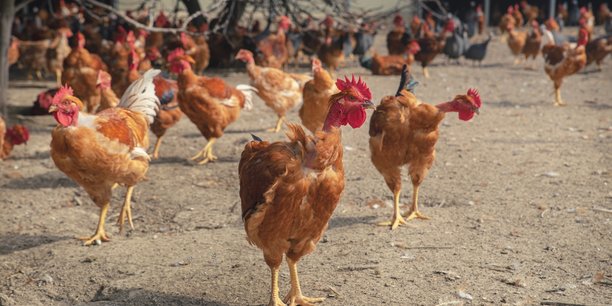Twenty million chickens, turkeys and ducks slaughtered last winter, 300 outbreaks detected since August: the H5N1 virus is wreaking havoc. At the end of December 2022, the European Food Safety Authority (EFSA) mentioned an animal epidemic or epizootic “the largest ever observed in Europe”. In France, the health authorities are completing the latest studies around the future Vaccination Plan.
Since it appeared 20 years ago, this flu, or rather this avian influenza, has never caused so many outbreaks on farms and cases in wild birds, as Claire Hautefeuille, veterinary epidemiologist and researcher at the Center for research for agricultural development (CIRAD): “ The virus is now present all over the world and recently in South America, an area rather spared until then. Last summer, the disease persisted, suggesting that it has become endemic in wild birds in Europe. » As it contaminates different species, it is no longer limited to migrants.
Which vaccines for which birds?
Faced with the increased risk, the Ministry of Agriculture wishes to launch a vaccination program. At the same time, veterinary medicine is evaluating two H5N1 vaccines: that of the Ceva animal health laboratory (Gironde) and that of the German laboratory Boerhinger Ingelheim. In this experiment, France is testing these two formulas on breeding ducks, while Italy is testing its own on turkeys and the Netherlands on hens. Objective: to measure the efficacy and safety of these vaccines according to the species.
If the European Commission has long banned vaccination on the grounds of export rules, it has just reviewed its position, as explained by Gilles Salvat, Deputy Director General of the Research and Reference Center of the National Health Security Agency (Anses) . ” It authorizes their experimentation on condition that the vaccinated herds are carefully monitored. It is a question of verifying that no bird carries a virus quietly that it could disseminate in the breeding circuit. For Europe, it is essential to reassure customers from third countries who fear importing animals in incubation, without symptoms under the effect of the vaccine. »
The experience of asymptomatic Covid-19 patients who dispersed the virus calls for caution. Another question: what can be the economic and health impact depending on the type of vaccination chosen, which species to vaccinate, massively or around the clusters? ” The results of all the analyzes will be communicated to the ministry in early April.l, specifies Gilles Salvat, so that he chooses the chosen scenario and orders the number of doses required. »
How to prevent duck clusters?
At Boerhinger Ingelheim, the vaccine used in the current experiment is Volvac Best H5. ” This vaccine has proven its safety and protective efficacy in ducks in other countriessays Magali Hainaut, innovation director of this lab. We participate in discussions around the vaccination plan and have already reserved 48 million doses for France, as part of a future call for projects ».
Even before vaccination, H5N1 health surveillance has also been strengthened: 100% of farms are under increased veterinary surveillance, with secure circuits and PCR tests before any herd movement. In nature, virus surveillance is passive, but real. Deceased wild birds are identified by the League for the Protection of Birds (LPO), the SAGIR infectious disease surveillance network with the French Office for Biodiversity and the Federation of Hunters. The remains are tested to identify the virus in order to delimit the areas of contamination. Since last summer, this watch has spotted contaminated gulls and terns, but also more recently seagulls in the Île-de-France region. However, H5N1 no longer attacks only birds. With eight genes, it produces many variants, some of which adapt to new species. Another bad memory of the coronavirus.
Which H5N1 species jumps?
Since its emergence in 2020, H5N1 has indeed infected various mammals: sea lions, mink in Spain, foxes in the forest of Seine-et-Marne and even a domestic cat next to a contaminated farm. Depending on the mutations or reassortments, these variants adapt their capacities. For example, some remain active at temperatures of mammals (37/38°C) lower than those of birds (40/42°C). These adaptations make it a virus with “zoonotic potential”, that is to say capable of infecting us.
For the moment, the influenza disease has infected “only” 870 people for twenty years and it is still not contagious between two individuals. Dr Sibylle Bernard-Stoecklin is an epidemiologist at the Department of Infectious Diseases of Public Health France: “ For the past year, the H5N1 subtype and its clade (A clade is a group of plants, microbes or genetically very similar animals with the same origin, Ed) which is rampant in Europe has infected six people in China, the United Kingdom, the United States United States and Ecuador in particular. These six cases are few compared to other avian influenza viruses such as H7N9. But the more mammals this virus infects, the more it is likely to acquire mutations that favor its adaptation to humans and its ability to become contagious.. For now, patients have always been contaminated by contact with sick animals. But any virus can hone its skills.
The experience of the virus on pigs giving it weapons to attack humans, the health watch monitors in particular pig farms close to those of poultry. ” It is essential to detect human cases as soon as possible to avoid chains of spread. We make employees in the poultry sector aware of the symptoms to watch for in which cases. »
For many years, networks and NGOs have been working to monitor the risks of zoonosis in areas where humans mix with many animals. But this surveillance operates in an unstructured and discontinuous way, depending on the funding allocated. Launched by France, the international PREZODE initiative will promote this surveillance from the local to the global level, in order to detect infections in animals and humans. Objective: avoid cash transfers and limit the spread.
Towards an influenza pandemic?
One thing is clear, avian influenza was considered by the WHO as a pandemic risk even before the coronavirus “surprise”. Transmissible by the breath – therefore contagious – and attacking the bottom of the pulmonary alveoli – therefore dangerous – this disease is one of the major health risks. Already, Sanofi-Aventis and GSK are working on the H5N1 vaccine. In the event of a pandemic and as for the seasonal flu, it is the WHO which will define against which clades of the virus the vaccines must be developed.
A virologist at the Institut Pasteur, Sylvie van der Werf regularly assesses infectious risks: ” You will have to worry if there are several human cases unrelated to a sick animal. This would suggest that the person has been infected by their environment or by another contagious individual. We already know some elements that can favor the power to infect mammals – of which we are part – and those that then favor contagiousness. The H5N1 risk varies according to these elements ».
In the meantime, scientists have just announced that raccoon dogs may be the intermediate hosts of SARS-CoV-02 between bats and us. Traveling viruses that do not stop at a single species as long as they can infect and reproduce.

